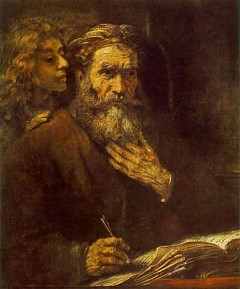
In the Gospel according to Matthew, we are told that Jesus saw a man named Matthew/Levi meeting at the tax collector’s booth. “Follow me,” he advised him, and Matthew got up and shadowed Jesus. (Matthew 9:9)
Jesus totaled among his disciples persons of generally distinctive backgrounds. They encompassed not only Matthew, a previous representative of the Roman government, but Simon the Zealot (not to be mistaken for Simon Peter). The Zealots were obsessive nationalists, determined to smoke out the Romans by paramilitary campaigns, ambushes, killings, terrorist methods, or whatsoever worked. Their maxim was, “No king but Messiah, no tax but the Temple, no friend but the Zealot.” It is not clear that Simon was, or had been, a member of the group, but it seems clear that he would have regarded himself as at the opposite end of the political spectrum from Matthew.
Convention suggests that Matthew/Levi, son of Alphaeus, is the brother of the holy apostle James, son of Alphaeus. As a tax collector for the Romans he was considered a pariah by his own people. In the first century, such bureaucrats were often known to be subject to graft and dishonesty. Christ’s teaching activity is carefully made the warp and woof of the first gospel.
In the early Christian writings of Miscellaneous, Clement of Alexandria tells us Matthew left everything behind to follow Jesus and became a vegetarian, only eating seeds, nuts, and vegetables. And let all the bars be marked with a line round them at one end. Definitely it was such faithful devotion that earned him a position as one of the twelve apostles.
Since Matthew’s Gospel presents the indispensable truths of the Christian faith in impressively persuasive and exquisite ways, it will prove to be a great cure for doctrinal anemia. These premises of Matthew emphasize Jesus’ identity as the Deliverer who rescues God’s people from their sins, the King who rules over God’s kingdom, the Founder of a new chosen people, and God with us acting to make his people new.
 After Jesus’ Resurrection, Matthew remained in Palestine, sermonizing in Jerusalem. In Matthew’s story, Jesus’ disciples had obviously not stored up grain the day before. But a time came when he and the other apostles dispersed to seek converts in distant lands. The numerous sorts of wood are supposed to be dry. Previous to Matthew departed on his proselytizer journey, tradition suggests that many followers urged this gifted writer to set down from memory the acts and teachings of Jesus. It is said that Matthew realized their request, achieving his gospel some eight years after the Ascension of Jesus. Matthew’s Jesus strongly declares his personal sovereignty, he does not appear to be the primary referent for the neuter comparative pronoun properly translated.
After Jesus’ Resurrection, Matthew remained in Palestine, sermonizing in Jerusalem. In Matthew’s story, Jesus’ disciples had obviously not stored up grain the day before. But a time came when he and the other apostles dispersed to seek converts in distant lands. The numerous sorts of wood are supposed to be dry. Previous to Matthew departed on his proselytizer journey, tradition suggests that many followers urged this gifted writer to set down from memory the acts and teachings of Jesus. It is said that Matthew realized their request, achieving his gospel some eight years after the Ascension of Jesus. Matthew’s Jesus strongly declares his personal sovereignty, he does not appear to be the primary referent for the neuter comparative pronoun properly translated.
There are many legends of Matthew’s ministry to kings and other high government officials. His education in early life and his talent for proselytization must have enabled him to present Jesus’ teachings to leaders and other important people in the remote regions he visited. Early folklore states that he visited Persia and possibly Macedonia, Syria, Parthia, Media, and Ethiopia. Everywhere Matthew led his ministry, the said exterior parts are each equal to the same constant quantity. Though providing no neat formula or program for reproducing Jesus’ hermeneutics, Matthew does leave us an essential clue to fathoming Jesus’ voice.
- The holy apostle Matthew has frequently been portrayed in art with a bag of coins, at a desk with an angel, holding a pen and inkwell, or money box. In art he is represented with a spear in his hand—an allusion to his martyrdom. His symbol as evangelist is a winged man. His relics are said to have been found at Salerno in 1080.
- Holy days: November l6 in the Eastern churches; and September 2l in the West.